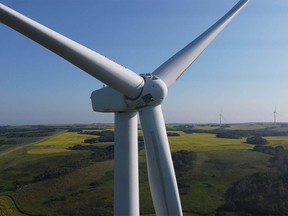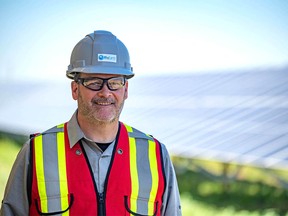
Alberta remained a powerful magnet for investment in Canada’s renewable sector last year, home to a whopping 92 per cent of the country’s growth in installed wind and solar capacity.
It’s a figure the Canadian Renewable Energy Association, which tracks the data, calls “remarkable,” but it also arrives as a contentious pause has been placed on approving new wind and solar projects in Alberta — at least until the end of this month.
Rules and policies overseeing future developments in Alberta are coming, even as competition from other provinces ramps up for such investment.
“Alberta has been remarkable for multiple years in a row,” association CEO Vittoria Bellissimo said Tuesday, noting the province’s open electricity market has helped attract spending in recent years.
“The 92 per cent speaks to what was built in 2023, but it doesn’t really speak to the diversification that is on the horizon across the country. And Albertans should look at that as competition.”
According to the industry group, Alberta added two gigawatts (GW) of installed wind and solar capacity in 2023, while the entire country saw a total of 2.16 GW of new capacity.
And in 2022, the province was also home to three-quarters of all new wind and solar generation capacity.
Last year’s bonanza came even with Alberta’s mid-year pause on new project approval, which was put in place in August. Developments already under construction were not affected by the temporary moratorium.
The UCP government is now examining policies to oversee the industry’s rapid growth, including its use of farmland and the potential for mandatory reclamation security requirements.
In an interview last week, Premier Danielle Smith reiterated the pause will end on Feb. 29, and addressed the issue of using farmland for renewable energy facilities.
“The industry should expect that as they’re building out and getting approvals for these installations, we are not going to be sterilizing prime agricultural land,” Smith said.
“They will have to be looking at either agrivoltaics, or they’ll have to be looking at marginal lands. And there really are some innovative designs that allow for the panels to be far enough apart so that you can run a combine through them or graze cattle . . . We just don’t want to be sterilizing agriculture land.”
-
 Wind and sun come through to help Alberta electricity operator end extreme-cold grid alerts
Wind and sun come through to help Alberta electricity operator end extreme-cold grid alerts -
 Alberta’s renewable energy pause could become lingering stumble, observers say
Alberta’s renewable energy pause could become lingering stumble, observers say -
 Varcoe: Smith defends Alberta’s pause on renewable projects to clean energy leaders as ‘waiting game’ continues
Varcoe: Smith defends Alberta’s pause on renewable projects to clean energy leaders as ‘waiting game’ continues -
 ‘They pulled the rug out’: Some communities oppose Alberta’s pause on renewable energy approvals
‘They pulled the rug out’: Some communities oppose Alberta’s pause on renewable energy approvals -
 Renewables pause in Alberta affecting 118 projects worth $33 billion, think tank says
Renewables pause in Alberta affecting 118 projects worth $33 billion, think tank says
According to the U.S. Department of Energy, agrivoltaics are solar photovoltaic systems built in such a way that allows for agricultural production — such as crops or livestock — on the land. There are 314 such projects identified in the United States.
Alberta’s policy will also discuss how new developments can use existing transmission infrastructure, to reduce system costs, and requirements for site reclamation once a project reaches the end of its life, Smith noted.
“We need to develop a plan to have the money set aside when they’re removed, but also have a plan to ensure that we’re able to recycle those panels, as well as the turbines, when they get removed,” the premier said.
“People shouldn’t be surprised to see that there will be some requirement for having a plan to ensure the money is there when those come to the end of their natural life.
“And also on transmission policy . . . you will see that we’re going to strongly incentivize co-location, so we can make better use of our existing infrastructure.”
There is also an opportunity for microgeneration, and the province will try to create a framework that “incentivizes that kind of installation as well,” Smith added.
Bellissimo noted that most agreements between private landowners and renewable project developers already include provisions for site reclamation plans.
Sara Hastings-Simon of the University of Calgary’s School of Public Policy said Smith’s remarks have her questioning “what the need for — and the justification of — a pause was,” noting some issues are already being addressed by the sector.
“In renewables, unlike oil and gas, landowners have a choice whether or not they want these projects on their land,” Hastings-Simon said.
“Yes, we should have remediation plans and ensure the money is set aside, but I would like to see the provincial government apply this to all forms of energy development, not just one form.”

Whatever happens, Alberta will need to ensure there’s investment certainty moving forward, say developers.
Alberta’s strong wind and solar resources, along with the structure of the province’s deregulated power market, have helped attract billions of dollars in investment in recent years.
The deregulated market allows developers to build new wind or solar facilities and sell the electricity, along with associated renewable energy credits, to corporate customers through power purchase agreements.
According to the Business Renewables Centre Canada, corporate-based PPAs have attracted more than $6.4 billion in investment — including $2.4 billion for projects announced last year — and enabled more than four gigawatts of renewable capacity from new projects since 2019.
Other provinces such as B.C. and Quebec are moving forward with more renewable energy procurement programs, which will increase the competition for investment.
Grant Arnold, CEO of BluEarth Renewables of Calgary, which has about 333 megawatts of wind and solar operating in Alberta — and another 400 megawatts of proposed projects — said the company hasn’t cancelled any developments due to the pause.
But it has spent more time and money on the early stages of project development and engineering work in other jurisdictions.

As for the provincial review, Arnold said he doesn’t want to see any “artificial barriers” adopted that penalize one form of power generation over another, and believes any new rules should be forward-looking and not affect existing projects.
“I would really like to see a signal that they would like us to invest more in the province. It’s something we want to do but, again, we’re looking for investor certainty,” he added.
“Alberta is sitting in a great spot from a resource perspective and (as a) place to invest, should the conditions return. So I’m really hoping that we can do that and keep some dollars in Alberta.”
Chris Varcoe is a Calgary Herald columnist.
You can read more of the news on source





